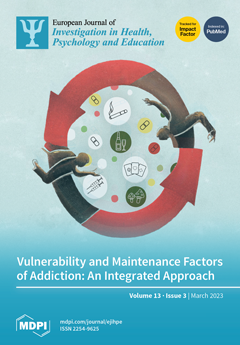Background: The passage through university is a complex experience that can heighten personal susceptibility to eating disorders. The objective of this research is to determine how gender, age, course, educational faculty, and body mass index (BMI) can influence the risk of eating disorders
[...] Read more.
Background: The passage through university is a complex experience that can heighten personal susceptibility to eating disorders. The objective of this research is to determine how gender, age, course, educational faculty, and body mass index (BMI) can influence the risk of eating disorders among university students. Method: A transversal and descriptive study is conducted with a sample of 516 Spanish students (57.2% female, 42.8% male;
Mage = 21.7,
SDage = 4.1) following 26 university degrees. The Inventory Eating Disorder-Reference criterion (EDI-3-RF) was administered to the students. Contingency tables were used between categorical variables with the chi-squared statistic, at a significance level of
p < 0.05. The Student
t-test was used for two independent samples and a one-way ANOVA test with the post hoc Bonferroni test for more than two groups. Pearson’s correlation and a simple linear regression analysis were used to analyze the relationship between the variables in its quantitative version. Results: It was found that the female students enrolled in the second year presented a greater obsession with thinness and body dissatisfaction (
p = 0.029;
d = 0.338); the male students practiced more physical exercise to control their weight (
p = 0.003); and that students under the age of twenty (
p < 0.010;
d = 0.584) and students from both the Health (
p = 0.0.13) and Law (
p = 0.021) educational faculties showed greater bulimic behavior (
d = 0.070). More females are underweight (
z = 2.8), and more men are overweight (
z = 2.4). Normal-weight students scored significantly higher in thinness obsession (
p = 0.033). Overweight students scored significantly higher on thinness obsession (
p < 0.001) and body dissatisfaction (
p < 0.001). Obese students scored significantly higher on body dissatisfaction (
p = 0.04). Conclusions: The data obtained in this study, reinforce the hypothesis that the female gender, at an age within the limits of early adolescence, in the first year of the degree courses, with specific university qualifications, and a high BMI constituted factors that could provoke an eating disorder. Consequently, it is necessary to implement preventive measures adapted to the circumstances of each university student.
Full article






